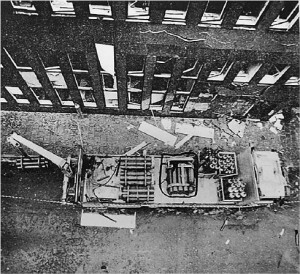A hydrogen gas explosion occurred just before 9:00 a.m. on Brahegatan, a street located in the city centre.
An open backed truck was delivering various industrial gases to sites in the Stockholm area. At the time of the accident, a rack of argon gas bottles was being delivered to a laboratory in the building adjacent to the truck.
The small lifting arm at the back of the truck was being used to offload the argon gas bottles when the operator (truck driver) heard a hissing sound. The operator stopped what he was doing and went to investigate the source of the sound at which point an explosion took place.
The facade of the nearest building (office block housing a laboratory) was heavily damaged and broken windows were reported within a radius of 90 m ; 16 people were injured and 10 vehicles damaged.
180 Nm³ of hydrogen was stored in a rack of 18 interconnected 50 l industrial pressure vessels (200 bar working pressure / tested at 300 bar every 5 years, last one in September 1981) being carried on the back of the delivery truck. Shut-off valves were not used to secure the individual cylinders in the rack.
The accident investigation found that the explosion was due to the ignition of a flammable cloud of hydrogen (UVCE). The release of hydrogen resulted from two broken connections between pressure vessels adjacent to 6mm diameter T-connection outlets from the cylinders ; 10 % of the flammable mixture released was burned in the deflagration (thst is 18 Nm³ (1.5 kg) of hydrogen).




